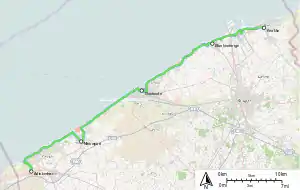Coast Tram (Belgium)
The Coast Tram (Dutch: Kusttram) is a public transport service connecting the cities and towns along the entire Belgian (West Flanders) coast, between De Panne near the French border and Knokke-Heist near the Dutch border. At 67 kilometres (42 mi) in length, it is the world's longest tram/light rail line currently in service,[1] as well as one of the few interurban tramways in the world to remain in operation. The line is built at 1,000 mm (3 ft 3 3⁄8 in) metre gauge and fully electrified at 600 V DC.
| Coast Tram | |
|---|---|
| Kusttram | |
| De Lijn Vicinal Tramways | |
 Map of the route | |
| Operation | |
| Locale | Belgian coastal towns from Knokke-Heist to De Panne. |
| Open | 1885 |
| Status | In Service |
| Owner(s) | De Lijn |
| Infrastructure | |
| Track gauge | 1,000 mm (3 ft 3 3⁄8 in) metre gauge |
| Electrification | 600 V DC |
| Depot(s) | Adinkerke, De Panne, Nieuwpoortsesteenweg, Oostende, Knokke-Heist |
| Stock | BN series 6000, + HermeLijn from Antwerp or Ghent.(temporary) |
| Statistics | |
| Route length | 67 km (41.63 mi) |
| Website | De Kusttram |
| Belgian Coast Tram | ||||||||||||||||||||||||||||||||||||||||||||||||||||||||||||||||||||||||||||||||||||||||||||||||||||||||||||||||||||||||||||||||||||||||||||||||||||||||||||||||||||||||||||||||||||||||||||||||||||||||||||||||||||||||||||||||||||||||||||||||||||||||||||||||||||||||||||||||||||||||||||||||||||||||||||||||||||||||||||||||||||||||||||||||||||||||||||||||||||||||||||||||||||||||||||||||||||||||||||||||||||||||||||||||||||||||||||||||||||||||||||||||||||||||||||||||||||||||||||||||
|---|---|---|---|---|---|---|---|---|---|---|---|---|---|---|---|---|---|---|---|---|---|---|---|---|---|---|---|---|---|---|---|---|---|---|---|---|---|---|---|---|---|---|---|---|---|---|---|---|---|---|---|---|---|---|---|---|---|---|---|---|---|---|---|---|---|---|---|---|---|---|---|---|---|---|---|---|---|---|---|---|---|---|---|---|---|---|---|---|---|---|---|---|---|---|---|---|---|---|---|---|---|---|---|---|---|---|---|---|---|---|---|---|---|---|---|---|---|---|---|---|---|---|---|---|---|---|---|---|---|---|---|---|---|---|---|---|---|---|---|---|---|---|---|---|---|---|---|---|---|---|---|---|---|---|---|---|---|---|---|---|---|---|---|---|---|---|---|---|---|---|---|---|---|---|---|---|---|---|---|---|---|---|---|---|---|---|---|---|---|---|---|---|---|---|---|---|---|---|---|---|---|---|---|---|---|---|---|---|---|---|---|---|---|---|---|---|---|---|---|---|---|---|---|---|---|---|---|---|---|---|---|---|---|---|---|---|---|---|---|---|---|---|---|---|---|---|---|---|---|---|---|---|---|---|---|---|---|---|---|---|---|---|---|---|---|---|---|---|---|---|---|---|---|---|---|---|---|---|---|---|---|---|---|---|---|---|---|---|---|---|---|---|---|---|---|---|---|---|---|---|---|---|---|---|---|---|---|---|---|---|---|---|---|---|---|---|---|---|---|---|---|---|---|---|---|---|---|---|---|---|---|---|---|---|---|---|---|---|---|---|---|---|---|---|---|---|---|---|---|---|---|---|---|---|---|---|---|---|---|---|---|---|---|---|---|---|---|---|---|---|---|---|---|---|---|---|---|---|---|---|---|---|---|---|---|---|---|---|---|---|---|---|---|---|---|---|---|---|---|---|---|---|---|---|---|---|---|---|---|---|---|---|---|---|---|---|---|---|---|---|---|---|---|---|---|---|---|---|---|---|---|---|---|---|---|---|---|---|---|---|---|---|---|---|---|---|---|---|---|---|---|---|---|---|---|---|---|---|---|---|---|---|---|---|---|---|---|---|---|---|---|---|---|---|---|---|---|---|---|---|
| ||||||||||||||||||||||||||||||||||||||||||||||||||||||||||||||||||||||||||||||||||||||||||||||||||||||||||||||||||||||||||||||||||||||||||||||||||||||||||||||||||||||||||||||||||||||||||||||||||||||||||||||||||||||||||||||||||||||||||||||||||||||||||||||||||||||||||||||||||||||||||||||||||||||||||||||||||||||||||||||||||||||||||||||||||||||||||||||||||||||||||||||||||||||||||||||||||||||||||||||||||||||||||||||||||||||||||||||||||||||||||||||||||||||||||||||||||||||||||||||||
In 2022, the A Line in Los Angeles, California will supersede the Coast Tram at 79.7 kilometres (49.5 mi) as the longest light rail/interurban line in the world.[2]
History
The first section of the line between Ostend and Nieuwpoort was opened in 1885, although the original route was further inland than the modern one and only short parts of the original section in Oostende and Nieuwpoort centres are still in operation. On its creation, the line was managed by the NMVB (Nationale Maatschappij van Buurtspoorwegen), that operated an interurban tram system throughout Belgium. In 1991, the NMVB/SNCV was broken into two regional companies, one Walloon and the other Flemish, with the Flemish successor company, Vlaamse Vervoermaatschappij De Lijn taking responsibility for operation of the coastal tram.
Characteristics

The service makes 67[3] stops along the ca.67 km line, with a tram running every 10 min during the peak summer months (every 20 min in the winter months), and it is used by over 15[4] million passengers per year. The service has been made more accessible by new low-floor centre sections to existing vehicles and a few new HermeLijn low-floor trams.(temporary,in summer) (from Ghent and Antwerp). In 2021, new CAF trams will come into service to replace the old trams. They are completely low-floor and longer than the old trams.
While most of the older trams are unidirectional and so have to be turned on a loop in order to reverse direction, the newer ones are bidirectional, with driving positions and doors on both end/sides.
Interesting features are the sea-view between Oostende and Middelkerke, the tracks through the dunes at De Haan, the high-speed, and the two alternative routes that exist around both ends of the Leopoldkanaal locks, just east of Zeebrugge, and the similar single track diversion around the inland end of the Boudewijnkanaal lock. That avoids delays when the road bridge that the tram line normally follows is raised for boats passing under it. There is a similar feature at the southern end of Ostend station around the lock entrance to the Vlotdok.
The maximum speed is official 78 kilometres per hour (48 mph). This speed is common between the villages.
Gallery
 Tram in Oostende Henegouwenstraat stop (abandoned)
Tram in Oostende Henegouwenstraat stop (abandoned) Ostend(old tramstation, demolished in 2019)
Ostend(old tramstation, demolished in 2019) Tram in Oostende station (demolished in 2019)
Tram in Oostende station (demolished in 2019) Tram leaving De Haan station
Tram leaving De Haan station De Haan station(in service in 1902)
De Haan station(in service in 1902) A couple of trams in De Haan station
A couple of trams in De Haan station Tracks between De Haan and Wenduine
Tracks between De Haan and Wenduine Depot at Adinkerke
Depot at Adinkerke Classic tram in 1980s (Blankenberge)
Classic tram in 1980s (Blankenberge) In 1986 Nieuwpoort
In 1986 Nieuwpoort Oostende in 1982
Oostende in 1982 Also in 1982 Oostende
Also in 1982 Oostende
References
- "Facts & Figures". Yarra Trams. Archived from the original on 29 May 2014. Retrieved 16 April 2013.
- Broverman, Neal (2016-10-07). "Metro's Regional Connector Will Change Everything Los Angeles Magazine". Los Angeles Magazine. Retrieved 2020-01-27.
- website "de lijn"
- see: Kusttram on Wikipedia.
External links
| Wikimedia Commons has media related to Coastal tram, Belgium. |
- (in English) De Kusttram (Official site)
- (in English) De Lijn (Official site)
- (in Dutch) Buurtspoorweg foto archief
- (in Dutch) TRAMANIA Buurtspoorweg sponsoring
- (in English) UrbanRail.net page